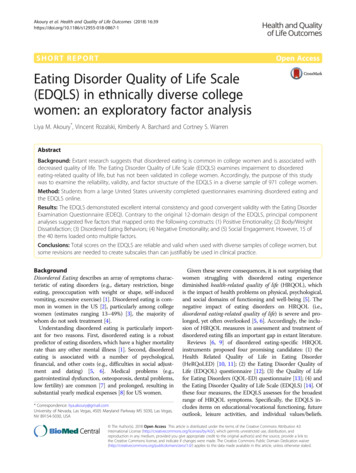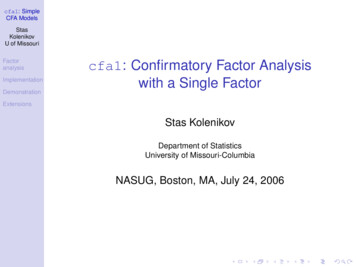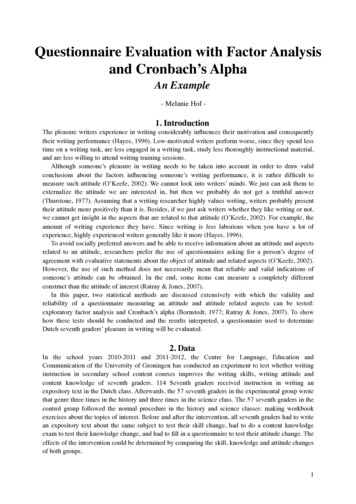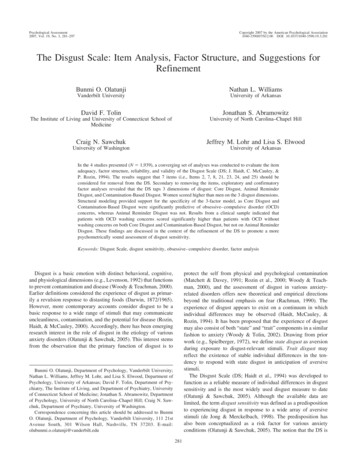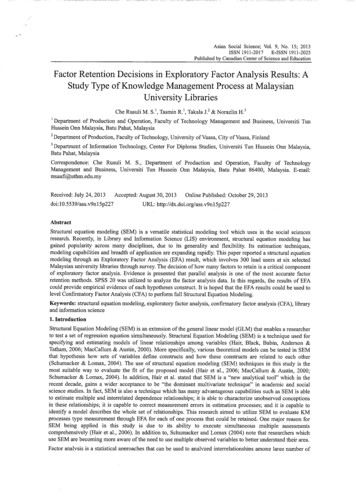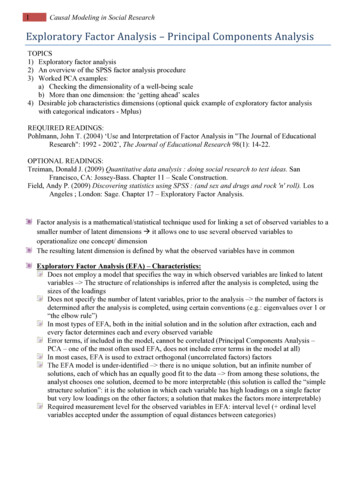
Transcription
Factor AnalysisAdvanced Financial Accounting IIÅbo Akademi School of Business
Factor analysis A statistical method used to describe variabilityamong observed variables in terms of fewerunobserved variables called factorsThe observed variables are modeled as linearcombinations of the factors plus error termsThe information gained about the interdependencies can be used later to reduce the set ofvariables in a datasetRelated to principal component analysis (PCA) PCA performs a variance-maximizing rotation of the variablespace, i.e. takes into account all variability in the variablesFactor analysis estimates how much of the variability is due tocommon factors
Factor analysisVariablesFactorsX1Factor 1X2X3Factor 2X4Factor k pXp
Factor analysis - an example:Financial ROEProfitabilityCF/SalesEquity RatioQRCRSolidity
Types/purposes of factor analysis Exploratory factor analysis Used to uncover the underlying structure of arelatively large set of variablesA priori assumption is that any indicator may beassociated with any factorNo prior theory, factor loadings are used to intuitthe factor structure of the dataConfirmatory factor analysis Seeks to determine if the number of factors and theloadings of the measured variables on themconfirm to what is expected on the basis of a preestablished theory
Factor analysis with SPSS Analyze Dimension Reduction FactorExtraction method, several alternatives e.g. Number of factors Principal Components (the most common)Maximum LikelihoodStatistically defined (based on eigenvalues)Used defined (Fixed) when prior assumption on factor structureRotation in order to extract a clearer factor pattern,several alternatives, e.g. VarimaxOblimin
Confirmatory Factor analysis - an example:Financial Ratios for Finnish listed companies 9 variables Fixed number of factors: 3 DSales, DAssets, EBIT-%, ROI, ROE, CashFlow(Operations)/Sales, Equity Ratio, Quick RatioCurrent RatioPredefined assumption on three factors: Growth,Profitability and SolidityExtraction method: Principal ComponentsAnalysis Rotation method: Varimax
Factor analysis: Component matrix(Factor loadings)Component123DSales (%),231,835,422Dassets 69,271-,155ROI,765,122-,408ROE,665,213-,459Equity Ratio,689-,422,247Quick Ratio,701-,431,429Current Ratio,645-,488,435
Factor loadings Called Component loadings in PCACorrelation coefficients between the variables (rows)and factors (columns) Values between -1 and 1The larger the absolute value of the factor loading, thestronger the connection between the variable and thefactorAnalogous to Pearson's r, the squared factor loadingis the percent of variance in that indicator variableexplained by the factor For example: 0,7012 0,491 49,1 % of the variabilityin Quick Ratio is explained by the first common factor
Interpreting the factor loadings androtating the loadings matrix A common problem in interpreting the unrotated factorloadings matrix is that all the most significant loadingsare concentrated in one or two first factorsOne way to obtain more interpretable results is to rotatethe solutionThe most common rotation method is Varimax rotation An orthogonal rotation (Rotated factors uncorrelated)Maximizes the variance of the squared loadings of a factoron all the variables in the matrixEach factor will tend to have either large or small loadingsof any particular variableYields results that make it as easy as possible to identifyeach variable with a single factor
Factor analysis: Varimax-rotatedcomponent matrixComponent123DSales (%),132-,055,953DAssets 71,183,248ROI,875,177,003ROE,834,037,031Equity Ratio,274,795-,086Quick Ratio,173,911,011Current Ratio,111,911-,042
Factor analysis - an example: Financial ratiosfor Finnish listed companies The three pre-assumed factors – Growth, Profitabilityand Solidity - may be clearly identified in the rotatedcomponent matrixFor example Growth is represented by component 3combining the major part of ratios DSales and DAssetswith minor influences from the other seven variablesIn the same manner Profitability is represented bycomponent 1 and Solidity by component 2The component matrix may be further transformed into aComponent score coefficient matrix to be used to createnew ratios describing the factors
Factor analysis: CommunalitiesInitialExtractionDSales (%)1,000,928DAssets ROI1,000,766ROE1,000,698Equity Ratio1,000,715Quick Ratio1,000,861Current Ratio1,000,843
Communalities The communalities for a variable are computed bytaking the sum of the squared loadings for thatvariableMay be interpreted as multiple R2 values forregression models predicting the variables of interestfrom the factorsThe sum of the squared factor loadings for all factorsfor a given variable (row) is the variance in thatvariable accounted for by all the factors For example 86.1 % of the variation in Quick Ratio is explained bythe three common factors, 13.9 % is left unexplained
Communalities. One assessment of how well the model is doing canbe obtained from the communalities Adding up the communality values for individualvariables gives the Total communality of the model Values close to one indicate that the model explainsmost of the variation for the variablesIn the example case we have total communality of 7.182Dividing total communality by the number of variablesgives the percentage of variation explained in themodel In the example case 7.182/9 79.8 %
SPSS: Total Variance ExplainedComponentInitial EigenvaluesTotal% ofVarianceExtraction Sums of SquaredLoadingsCumulative%Total% 143100,000Even an Explorative FactorAnalysis with the defaulteigenvalue limit 1,0 in SPSSwould have resulted in extractíngthree factorsTotal varianceexplained by thethree factor model79.78 %
Factor analysis: Computing factorscores The observed nine ratios for Alma Media 2005 were DSalesDAssetsEBIT-%Cash Flow(Oper.)/SalesROIROEEquity RatioQuick RatioCurrent Ratio- 0.3846- 0.25800.14800.11790.26100.28400.52011.71192.9000
Factor analysis: Computing factor scores The nine variables may be summarized in three newvariables Profitability, Solidity and Growth bymultiplying the observed ratio values with componentscores: Profitability -0.053 (-0.3846) - 0.071 (0.2580) 0.314 0.1480 0.240 0.1179 0.360 0.2610 0.374 0.2840 - 0.025 0.5201- 0.108 1.7119 - 0.129 2.9000 -0.129 Solidity 1.230 Growth - 0.189
Alternative rotation methods:Orthogonal rotations Varimax Quartimax An orthogonal alternative which minimizes thenumber of factors needed to explain each variableGenerates often a general factor on which mostvariables are loaded to a high or medium degreeCreates a factor structure usually not helpful to theresearch purposeEquimax A compromise between Varimax and Quartimaxcriteria
Factor analysis with SPSS Analyze Dimension Reduction Factor Extraction method, several alternatives e.g. Principal Components (the most common) Maximum Likelihood Number of factors Statistically defined (based on eigenvalues) Used defined (Fixed) when prior assumption on factor structure Rotation in order to extract a clearer factor pattern,
